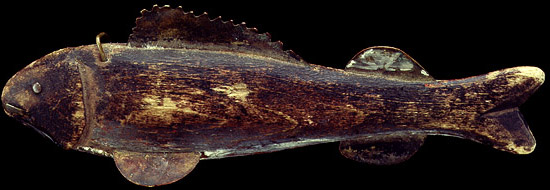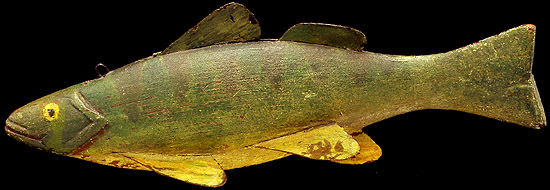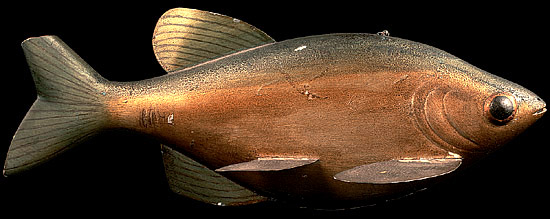Fish
are speared in fresh and seawaters all over the globe, but for
all practical purposes,
the use of fish effigies to attract game
into a fisherman's range is limited to North America.
Although
there may have been decoy use among ice fishermen in Northeast
Asia
in the remote past, the earliest examples are Eskimo with some examples believed
to be more that a thousand years old.

Bering
Straits Fish Decoy
Carved, drilled and incised Walrus ivory with inset stone eyes
and traces of white pigment.
Length
3",
Circa 1000AD
The ancient
migration patterns of earliest North Americans suggest a southern,
perhaps Great Lakes-area of origin for various details that have been
borrowed and adapted from elsewhere to the North. Tribal people frequently
borrowed ideas from other places and groups they contacted and may
even produce innovations which are borrowed back by the very groups
where the original idea originated.

Native American Fish Decoy / New York
State
Carved, charred wood with attached metal fins, brass tack eyes and
traces of original paint.
Length
4",
Circa 1850-1890

Harry
Seymour Green Sunfish Decoy / New York
State
Painted wood with attached metal fins, leather tail and brass tack
eyes.
Length
6.75"Circa
1890
The finely executed fish decoys we see today are often painted in
a style resonant of Northern European folk techniques. Contemporary
carver-fishermen utilize these stylistic variations that were learned
from descendants of the settlers they originally taught to fish with
decoys.

Oscar
Peterson Rainbow Trout Decoy
Painted wood with attached metal fins and nailhead eyes.
Length
12" Circa 1930

Fishing
by cutting holes in the ice and using decoys to bring fish within
spearing distance was totally unknown to the rest of the world,
and was adopted by Americans in the Upper Midwest who learned the
technique from indigenous fishermen in the early 19th Century.
European and colonial travelers learned of the use of decoys as tools
for fishing through the ice and are many stories of early encounters.
The following comes from the journals of fur trader Alexander Henry
at Sault Ste. Marie, Ontario around 1762.
.jpg)
"The Commandant and all the rest lived in one small house subsisting
only by hunting and fishing. The woods afforded us some hares and
partridges and we took large trout with the spear. In order to spear
the trout under the ice, holes being first cut of two yards in circumference,
cabins of about two feet in height built over them of small branches
of trees and these further covered with skins so as to wholly exclude
the light. The design and result of this contrivance is to render
it practicable to discern objects in the water at a very considerable
depth, for the reflection of the light from the water gives… (the
ice) an opaque appearance and hides all objects from the eye at a
small distance beneath its surface.
A
spearhead of iron is fastened on a pole of about ten feet in length.
This instrument is lowered into the water and the fisherman, lying
upon his belly with his head under the cabin. He then lets down a
figure of a fish carved in wood and filled with lead. Round the middle
of the fish-effigy is tied a small packthread; when at the depth of
ten fathoms, where it is intended to be employed, it is made, by drawing
the string and by the simultaneous pressure of the water, to move
forward after the manner of a real fish.
Trout
and other large fish, deceived by its resemblance, spring forward
to seize it: but by a dexterous jerking of the string, it is instantly
taken from their reach. The decoy is now drawn near to the surface
and the fish takes some time to renew the attack, during which time,
the spear is raised and held conveniently for striking. On the return
of the fish, the spear is plunged into its back and, the spear being
barbed, is drawn out of the water."

With
the exception of the language, this could
be a description of Ice fishing Indian style, circa 2012. Although
there are variations on the details, with branch enclosure being replaced
by Nylon tents, the variations do not obscure the fact that the use
of fish decoys represent a venerable aspect of an ancient method of
fishing.

Harry
Seymour Green Sunfish Decoy / New York
State
Painted wood with attached metal fins, leather tail and brass tack
eyes.
Length
6.75"Circa
1890
Around
the Great Lakes and in upstate New York, a lively ice fishing culture
was in place by the second half of the 19th century. The scene was
so active and so disturbing to some parties that ice fishing was
outlawed for everyone except certain Native Americans on their reservations
in 1910.

Abraham DeHate Bass Decoy/ Mt. Clemens, Michigan
Painted wood with attached metal fins and brass tack eyes.
Length
13"Circa
1920
The
beginning of the Great Depression saw the end to this prohibition
as economic conditions created a need for new ways of creating income
and securing food. Ice spearfishing was resurrected into a major
enterprise for both sport and sustenance, with carvers and fish
decoy users active on the lakes and rivers of Michigan, Wisconsin, Minnesota & New York.

Yock
Meldrum Fish Decoy / Mt. Clemens, Michigan
Charred wood with attached metal fins
Length
5",
Circa 1930
The decoys produced during the depression ranged from Native
American designs in unpainted native woods to idiosyncratic
Americanized forms in woods and other materials which were brightly
colored and lavishly decorated.

South
Bend Factory Decoy
Carved, painted wood with glass bead eyes.
Length
6", Circa
1930
As
the popularity of the sport grew, the demand for ice-fishing decoys
far outstripped the supply and many decoys were were manufactured
by factories which sprang up to supply the angler's needs. These mass-produced
decoys, many of which are spectacularly carved and painted, are
now included within the collector's purview.
The finely executed fish decoys collected today are painted in
a style resonant of Northern European folk techniques. Contemporary
carver-fishermen utilize these stylistic variations that were learned
from descendants of the settlers they originally taught to fish with
decoys.

Oscar
Peterson Rainbow Trout Decoy
Painted wood with attached metal fins and nailhead eyes.
Length
12" Circa 1930
Certain
fish decoy makers were accepted as Master Carvers and were acknowledged as the best in the field during their own time.
Their reputations brought them recognition as artists whose works
were respected and eagerly sought after.

Hans
Janner, Sr. Bass Decoy / Mt. Clemens, Michigan
Painted wood with attached metal fins and inset glass eyes.
Length
11"Circa
1930

Augie
Janner Decoy /Mt.
Clemens, Michigan
Painted wood with attached metal fins and sign reflector eyes.
Length
6.75"Circa
1940

Larry
Peltier Perch Decoy / Mt. Clemens, Michigan
Painted wood with attached metal fins and painted eyes.
Length
8", Circa
1931

Yock Meldrum Moon-Eyed Shad Decoy / Mt.
Clemens, Michigan
Painted wood with attached metal fins and painted eyes.
Length
12"Circa 1935
Many
of these artists were sportsmen whose decoys were for personal
use, but their "fish" are so beautiful, it's easy to lose sight
of the fact that their creations were utilitarian in purpose.
The whimsical little fish were carved to feed their families
and their creations helped many a family survive the long Great
Lakes winters.
|